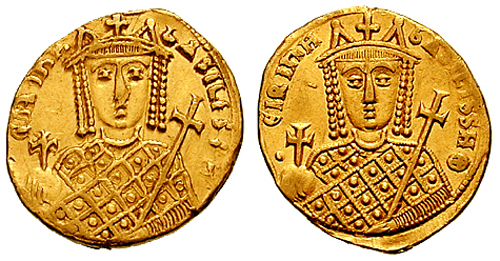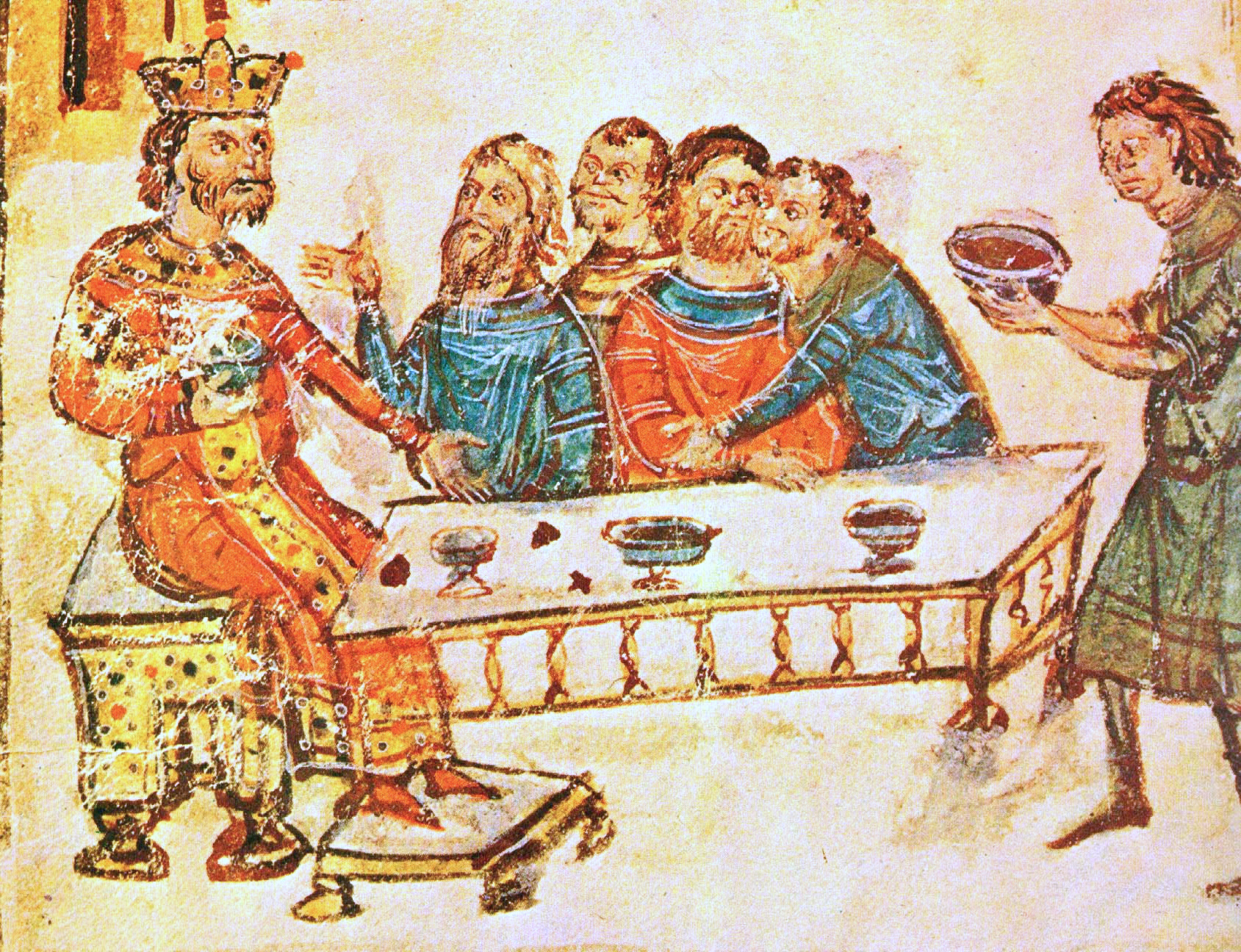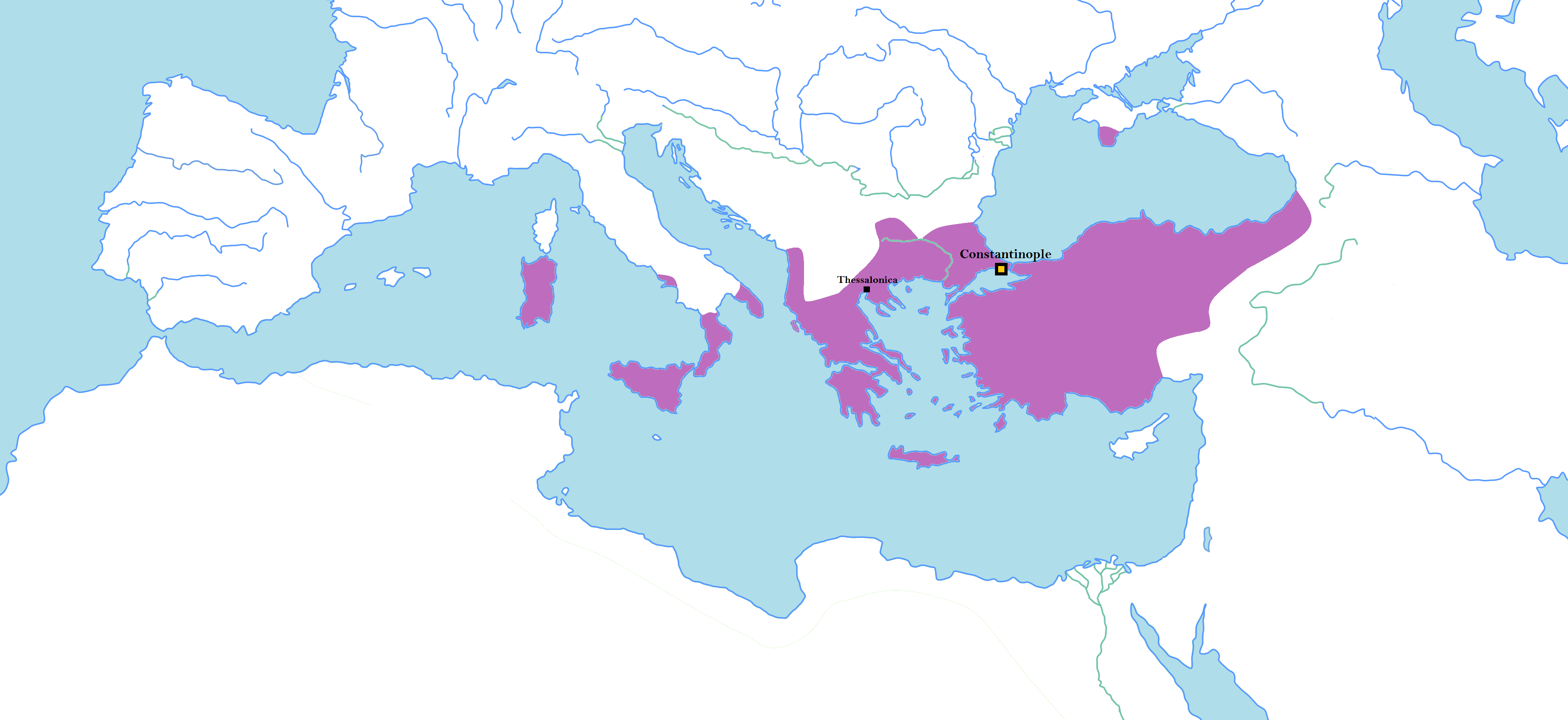|
803
__NOTOC__ Year 803 ( DCCCIII) was a common year starting on Sunday (link will display the full calendar) of the Julian calendar. Events By place Byzantine Empire * Emperors Nikephoros I and Charlemagne settle their imperial boundaries in the Adriatic Sea, and sign the Pax Nicephori ("Peace of Nikephoros"). The Byzantines retain control of the coastal cities and islands in Dalmatian Croatia, while Frankish rule is accepted over Istria and the Dalmatian hinterland. Venice is recognized as independent by the Byzantine Empire. * Summer – Bardanes Tourkos, Byzantine general (''strategos''), is proclaimed emperor by the troops of the Anatolic, Opsikion, Thracian and Bucellarian themes. The 'rebel' army marches to Chrysopolis, a suburb of Constantinople. After the defection of two of his trusted aids, future emperors Leo the Armenian and Michael the Amorian, Bardanes negotiates peace. Europe * May – Krum, ruler (khan) of the Bulgarian Empire, begins his territ ... [...More Info...] [...Related Items...] OR: [Wikipedia] [Google] [Baidu] |
Bardanes Tourkos
Bardanes, nicknamed ''Tourkos'', "the Turk" ( gr, Βαρδάνης ὁ Τοῦρκος, Bardanēs ho Tourkos, ), was a Byzantine general of Armenian origin who launched an unsuccessful rebellion against Emperor Nikephoros I () in 803. Although a major supporter of Byzantine empress Irene of Athens (), soon after her overthrow he was appointed by Nikephoros as commander-in-chief of the Anatolian armies. From this position, he launched a revolt in July 803, probably in opposition to Nikephoros's economic and religious policies. His troops marched towards Constantinople, but failed to win popular support. At this point, some of his major supporters deserted him and, reluctant to engage the loyalist forces in battle, Bardanes gave up and chose to surrender himself. He retired as a monk to a monastery he had founded. There he was blinded, possibly on Nikephoros's orders. Origin and early career Nothing is known of the early life of Bardanes. He is usually regarded by modern scholars ... [...More Info...] [...Related Items...] OR: [Wikipedia] [Google] [Baidu] |
First Bulgarian Empire
The First Bulgarian Empire ( cu, блъгарьско цѣсарьствиѥ, blagarysko tsesarystviye; bg, Първо българско царство) was a medieval Bulgar- Slavic and later Bulgarian state that existed in Southeastern Europe between the 7th and 11th centuries AD. It was founded in 680–681 after part of the Bulgars, led by Asparuh, moved south to the northeastern Balkans. There they secured Byzantine recognition of their right to settle south of the Danube by defeatingpossibly with the help of local South Slavic tribesthe Byzantine army led by Constantine IV. During the 9th and 10th century, Bulgaria at the height of its power spread from the Danube Bend to the Black Sea and from the Dnieper River to the Adriatic Sea and became an important power in the region competing with the Byzantine Empire. It became the foremost cultural and spiritual centre of south Slavic Europe throughout most of the Middle Ages. As the state solidified its position in th ... [...More Info...] [...Related Items...] OR: [Wikipedia] [Google] [Baidu] |
Pax Nicephori
''Pax Nicephori'', Latin for the "Peace of Nicephorus", is a term used to refer to both a peace treaty of 803, tentatively concluded between emperors Charlemagne, of the Frankish empire, and Nikephoros I, of the Byzantine empire, and the outcome of negotiations that took place between the same parties, but were concluded by successor emperors, between 811 and 814. The whole set of negotiations of the years 802–815 has also been referred to by this name. By its terms, after several years of diplomatic exchanges, the Byzantine emperor's representatives recognized the authority in the West of Charlemagne, and East and West negotiated their boundaries in the Adriatic Sea. Failed negotiations of 803 On Christmas Day in 800 AD, Pope Leo III crowned Charlemagne as ''Imperator Romanorum'' (Latin for "Emperor of the Romans") in Saint Peter's Basilica. Nikephoros I of the Byzantine Empire and Charlemagne tried to settle their imperial boundaries in 803. A first treaty was indeed prepared ... [...More Info...] [...Related Items...] OR: [Wikipedia] [Google] [Baidu] |
Krum
Krum ( bg, Крум, el, Κροῦμος/Kroumos), often referred to as Krum the Fearsome ( bg, Крум Страшни) was the Khan of Bulgaria from sometime between 796 and 803 until his death in 814. During his reign the Bulgarian territory doubled in size, spreading from the middle Danube to the Dnieper and from Odrin to the Tatra Mountains. His able and energetic rule brought law and order to Bulgaria and developed the rudiments of state organization. Biography Origins Krum was a Bulgar chieftain from Pannonia. His family background and the surroundings of his accession are unknown. It has been speculated that Krum might have been a descendant of the old Bulgar royal house of Kubrat. The name Krum is of Turkic origin and means "governor prince" (from '' kurum'' "rule, leadership, administration"). Establishment of new borders Around 805, Krum defeated the Avar Khaganate to destroy the remainder of the Avars and to restore Bulgar authority in Ongal again, the tradition ... [...More Info...] [...Related Items...] OR: [Wikipedia] [Google] [Baidu] |
Nikephoros I
Nikephoros I or Nicephorus I ( gr, Νικηφόρος; 750 – 26 July 811) was Byzantine emperor from 802 to 811. Having served Empress Irene as '' genikos logothetēs'', he subsequently ousted her from power and took the throne himself. In reference to his career before becoming emperor, he is sometimes surnamed "the Logothete" (ὁ Λογοθέτης) and "Genikos" or "Genicus" (ὁ Γενικός). Nikephoros pursued wars against the Arabs and Bulgarians, with mixed results; while invading Bulgaria he was defeated and killed at the Battle of Pliska. Background Sources outside the Byzantine context, including Michael the Syrian, al-Tabari, and Mas'udi, preserve the tradition that Nikephoros was of Ghassanid Arab origin. al-Tabari claims that he derived this information from Byzantine sources, but no surviving Byzantine chronicle makes explicit mention of the emperor's ethnic background. The modern scholar Paul Julius Alexander suggests that al-Tabari did transmit inform ... [...More Info...] [...Related Items...] OR: [Wikipedia] [Google] [Baidu] |
Adriatic Sea
The Adriatic Sea () is a body of water separating the Italian Peninsula from the Balkans, Balkan Peninsula. The Adriatic is the northernmost arm of the Mediterranean Sea, extending from the Strait of Otranto (where it connects to the Ionian Sea) to the northwest and the Po Valley. The countries with coasts on the Adriatic are Albania, Bosnia and Herzegovina, Croatia, Italy, Montenegro, and Slovenia. The Adriatic contains more than 1,300 islands, mostly located along the Croatian part of its eastern coast. It is divided into three basins, the northern being the shallowest and the southern being the deepest, with a maximum depth of . The Otranto Sill, an underwater ridge, is located at the border between the Adriatic and Ionian Seas. The prevailing currents flow counterclockwise from the Strait of Otranto, along the eastern coast and back to the strait along the western (Italian) coast. Tidal movements in the Adriatic are slight, although acqua alta, larger amplitudes are known to ... [...More Info...] [...Related Items...] OR: [Wikipedia] [Google] [Baidu] |
Transylvania
Transylvania ( ro, Ardeal or ; hu, Erdély; german: Siebenbürgen) is a historical and cultural region in Central Europe, encompassing central Romania. To the east and south its natural border is the Carpathian Mountains, and to the west the Apuseni Mountains. Broader definitions of Transylvania also include the western and northwestern Romanian regions of Crișana and Maramureș, and occasionally Banat. Transylvania is known for the scenery of its Carpathian landscape and its rich history. It also contains Romania's second-largest city, Cluj-Napoca, and other iconic cities and towns such as Brașov, Sibiu, Târgu Mureș, Alba Iulia and Sighișoara. It is also the home of some of Romania's UNESCO World Heritage Sites such as the Villages with fortified churches, the Historic Centre of Sighișoara, the Dacian Fortresses of the Orăștie Mountains and the Roșia Montană Mining Cultural Landscape. It was under the rule of the Agathyrsi, part of the Dacian Kingd ... [...More Info...] [...Related Items...] OR: [Wikipedia] [Google] [Baidu] |
Venice
Venice ( ; it, Venezia ; vec, Venesia or ) is a city in northeastern Italy and the capital of the Veneto region. It is built on a group of 118 small islands that are separated by canals and linked by over 400 bridges. The islands are in the shallow Venetian Lagoon, an enclosed bay lying between the mouths of the Po and the Piave rivers (more exactly between the Brenta and the Sile). In 2020, around 258,685 people resided in greater Venice or the ''Comune di Venezia'', of whom around 55,000 live in the historical island city of Venice (''centro storico'') and the rest on the mainland (''terraferma''). Together with the cities of Padua and Treviso, Venice is included in the Padua-Treviso-Venice Metropolitan Area (PATREVE), which is considered a statistical metropolitan area, with a total population of 2.6 million. The name is derived from the ancient Veneti people who inhabited the region by the 10th century BC. The city was historica ... [...More Info...] [...Related Items...] OR: [Wikipedia] [Google] [Baidu] |
Bulgars
The Bulgars (also Bulghars, Bulgari, Bolgars, Bolghars, Bolgari, Proto-Bulgarians) were Turkic semi-nomadic warrior tribes that flourished in the Pontic–Caspian steppe and the Volga region during the 7th century. They became known as nomadic equestrians in the Volga-Ural region, but some researchers say that their ethnic roots can be traced to Central Asia. During their westward migration across the Eurasian steppe, the Bulgar tribes absorbed other tribal groups and cultural influences in a process of ethnogenesis, including Iranian, Finnic and Hunnic tribes. Modern genetic research on Central Asian Turkic people and ethnic groups related to the Bulgars points to an affiliation with Western Eurasian populations. The Bulgars spoke a Turkic language, i.e. Bulgar language of Oghuric branch. They preserved the military titles, organization and customs of Eurasian steppes, as well as pagan shamanism and belief in the sky deity Tangra. The Bulgars became semi-sedentary du ... [...More Info...] [...Related Items...] OR: [Wikipedia] [Google] [Baidu] |
Byzantine Empire Under The Nikephorian Dynasty
Following the deposition of the Byzantine empress Irene of Athens, the throne of the Byzantine Empire passed to a relatively short-lived dynasty, the Nikephorian dynasty, named after its founder, Nikephoros I. The empire was in a weaker and more precarious position than it had been for a long time and its finances were problematic.Jenkins. Byzantium The Imperial Centuries AD 610-1071. p. 117 During this era Byzantium was almost continually at war on two frontiers which drained its resources, and like many of his predecessors, Nikephoros (802–811) himself died while campaigning against the Bulgars to the north. Furthermore, Byzantium's influence continued to wane in the west with the crowning of Charlemagne (800–814) as Holy Roman emperor by Pope Leo III at Old St. Peter's Basilica in Rome in the year 800 and the establishment of a new empire in Western Europe laying claim to the universal Roman monarchy. Nikephoros I, 802–811 Nikephoros I had been the empire's finance m ... [...More Info...] [...Related Items...] OR: [Wikipedia] [Google] [Baidu] |
Istria
Istria ( ; Croatian and Slovene: ; ist, Eîstria; Istro-Romanian, Italian and Venetian: ; formerly in Latin and in Ancient Greek) is the largest peninsula within the Adriatic Sea. The peninsula is located at the head of the Adriatic between the Gulf of Trieste and the Kvarner Gulf. It is shared by three countries: Croatia, Slovenia, and Italy.Marcel Cornis-Pope, John Neubauer''History of the literary cultures of East-Central Europe: junctures and disjunctures in the 19th And 20th Centuries'' John Benjamins Publishing Co. (2006), Alan John Day, Roger East, Richard Thomas''A political and economic dictionary of Eastern Europe'' Routledge, 1sr ed. (2002), Croatia encapsulates most of the Istrian peninsula with its Istria County. Geography The geographical features of Istria include the Učka/Monte Maggiore mountain range, which is the highest portion of the Ćićarija/Cicceria mountain range; the rivers Dragonja/Dragogna, Mirna/Quieto, Pazinčica, and Raša; and t ... [...More Info...] [...Related Items...] OR: [Wikipedia] [Google] [Baidu] |
Danube
The Danube ( ; ) is a river that was once a long-standing frontier of the Roman Empire and today connects 10 European countries, running through their territories or being a border. Originating in Germany, the Danube flows southeast for , passing through or bordering Austria, Slovakia, Hungary, Croatia, Serbia, Romania, Bulgaria, Moldova, and Ukraine before draining into the Black Sea. Its drainage basin extends into nine more countries. The largest cities on the river are Vienna, Budapest, Belgrade and Bratislava, all of which are the capitals of their respective countries; the Danube passes through four capital cities, more than any other river in the world. Five more capital cities lie in the Danube's basin: Bucharest, Sofia, Zagreb, Ljubljana and Sarajevo. The fourth-largest city in its basin is Munich, the capital of Bavaria, standing on the Isar River. The Danube is the second-longest river in Europe, after the Volga in Russia. It flows through much of C ... [...More Info...] [...Related Items...] OR: [Wikipedia] [Google] [Baidu] |
.png)





.jpg)

